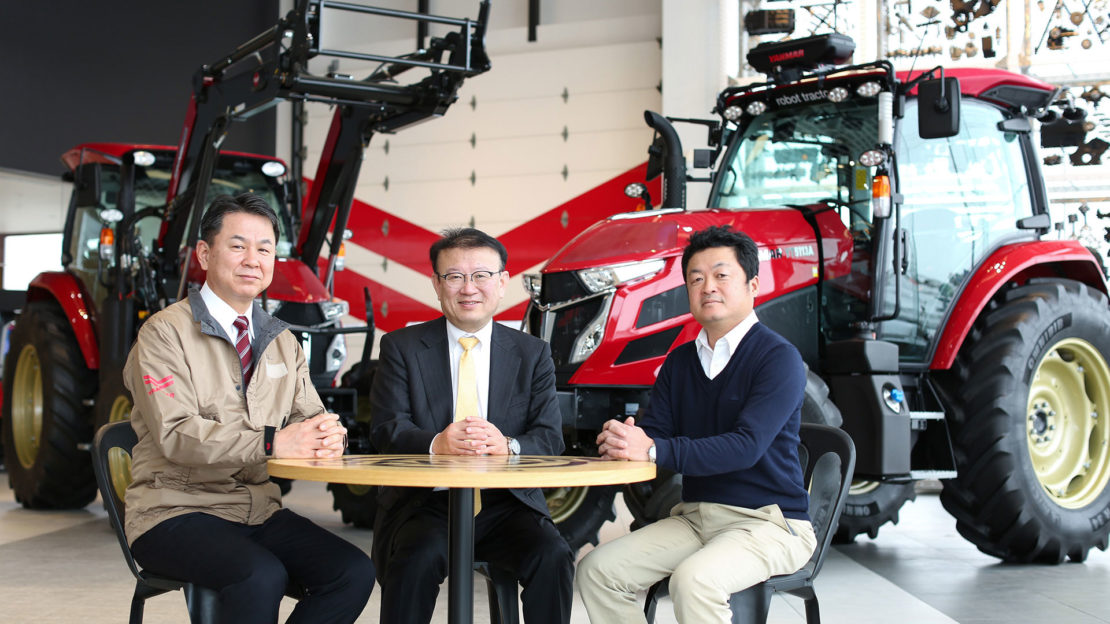From labor shortages to an aging population and a shortage of farmers in the next generation, Japan’s agriculture industry is dealing with a myriad of issues. At the same time, some in the industry are tackling these problems head on and see agricultural robotization as one approach to meeting the challenges facing the industry. Here at Y Media, we sat down and talked to the foremost figures in agriculture robotic research about the future of agriculture: Professor Noboru Noguchi, Graduate School of Agriculture / Research Faculty of Agriculture, Hokkaido University; Dry field farmer Hisashi Miura, who cooperated in the development of robot tractors; and Yanmar’s robot tractor developer, Shigemi Hidaka.
Noboru Noguchi
Vice Director of Research/Professor, Graduate School of Agriculture / Research Faculty of Agriculture, Hokkaido University. Dr. Noguchi studied agricultural engineering at Hokkaido University’s Research Faculty of Agriculture, where he later received his doctorate. He is also the director of the Cross-ministerial Strategic Innovation Promotion Program (SIP)’s “Next-generation Creative Technology of Agriculture, Forestry and Fisheries Industries” program.
Hisashi Miurai
Representative Director, Miura Farm Co., Ltd. After graduating from the Faculty of Agriculture, Iwate University and the Graduate School of Agriculture / Research Faculty of Agriculture, Hokkaido University, Mr. Miura found employment at an agricultural equipment manufacturer, before succeeding his grandfather’s farm at the age of 30. In addition to dry field farming of wheat, potatoes, pulse and beats across 99 hectares of fields, he currently cultivates Chinese yams, all under the banner of “practicing smart farming for the future.”
Shigemi Hidaka
Doctor of Agricultural Science, Executive Engineering Officer/Divisional Manager of Advanced Development, Project Management Division of the R&D Department, Yanmar Agribusiness Co., Ltd. Due to the influence of his farmer lineage, Dr. Hidaka joined Yanmar with a dream to develop tractors. Encountering Dr. Noguchi and Mr. Miura, he turned his attention to the development of robot tractors.
Issues in Japanese agriculture, key points for resolution
Q. What do you think about the challenges to Japan’s agricultural industry?
Noguchi Labor shortage is a major issue. The average age of primary farmers exceeds 67, with 65% of farmers being over 65 years of age. This average is predicted to rise over time. We’re also facing the reality of the number of workers declining 50% in the past thirty years where a 15% decrease is seen in just over the past five years alone. Another big problem we face is the lack of expert skills as farmers age and retire. Agriculture is all about experience and instinct, so this could possibly lead to a drop in productivity.
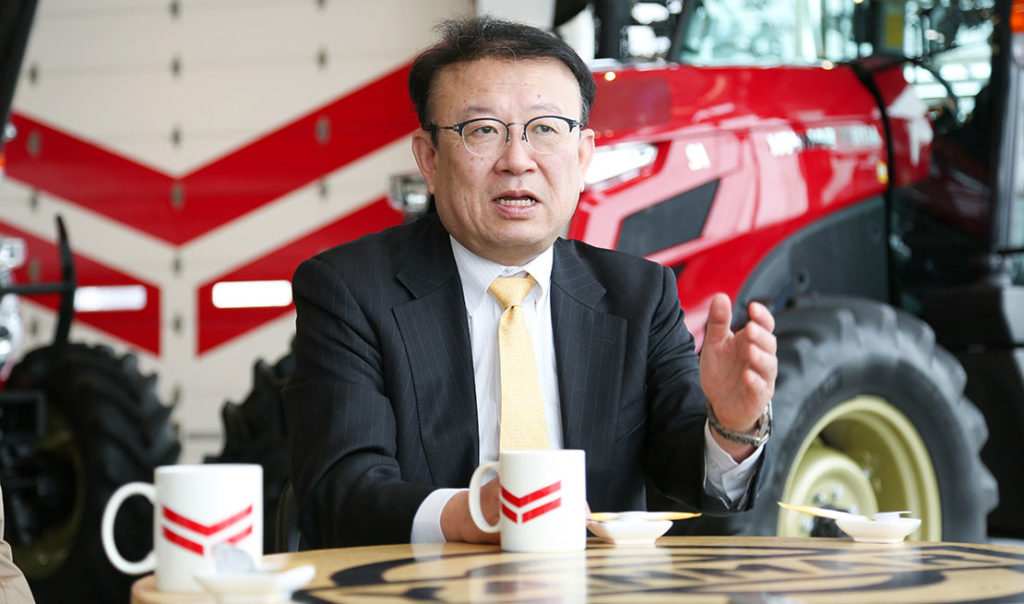
Miura Competition with imported agricultural produce has become more intense since I began working in the industry, forcing us to reduce production costs if we want to survive. Reducing costs does not mean working day and night. It comes down to either increasing mechanization or increasing the workforce. When I entered the agriculture industry, I considered purchasing foreign-made large-scale tractors and equipment to increase my fields to 13 hectares of land. But when I stopped and thought about it, foreign-made large tractors cost close to 200 thousand dollars. Using large farm equipment like those abroad, managing such a vast operation seemed completely untenable.
Hidaka Assisting plowing, sowing and harvesting work to increase production efficiency and quality seems obvious to me as an agricultural equipment manufacturer. With Yanmar being part of the agriculture industry for a long time, we find it essential not only to focus on agricultural production, but to look ahead to distribution, processing and sales that make up the food value chain.
Q. Is agricultural robotics one solution to these issues?
Noguchi I started working on automation of agricultural equipment back in 1991. There were large technical obstacles at the time. Satellite positioning technology is essential in autonomous driving. But the American GPS system at the time was imprecise and was expensive to use. Labor shortage wasn’t as big of an issue back then, and we treated it as a problem for another day. Afterward, there was a joint research project with the National Agriculture and Food Research Organization for the Ministry Agriculture, Forestry and Fisheries (MAFF), where autonomous driving became more realistic with the improvement of positioning technology.
Q. Mr. Miura, is it true you’ve been involved in the development of robot tractors from the prototype phase?
Miura Innovation in semi-autonomous driving technology occurred around the time I expanded my fields by 13 hectares. GPS signal correction used to have a calculation error of +-30 cm, but that was improved to +-3 cm. This allowed more use for semi-autonomous driving. In my farm, for example, female workers could work while riding these tractors. I realized that I could teach part-time staff to control the tractors, and that there were other methods to optimize my farm other than relying on large-scale agricultural equipment.
What’s more, working through a combination of auto tractors (semi-autonomous with a driver) and robot tractors (fully autonomous without a driver), anyone could work on the farm, and I could reduce my overall labor needs. What’s more, loading the field data not only allows it to run as expected, but there’s also the added benefit of this data being useful the following year as accumulated data for management.
With this in mind, I decided to visit Dr. Noguchi since I thought that this application could lead to futuristic agricultural methods.
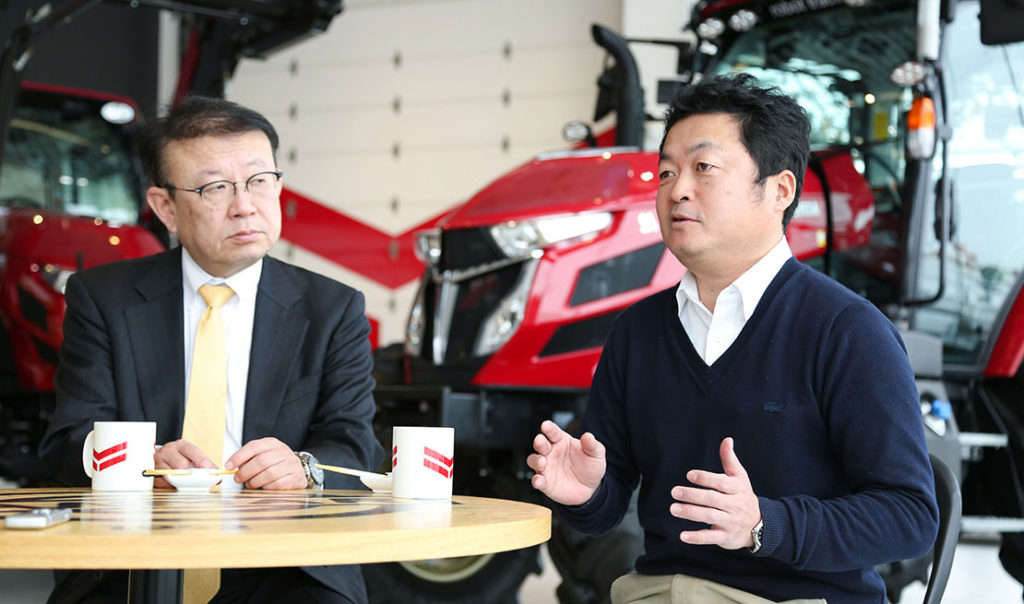
Farmers inspire breakthrough in robot agriculture development
Noguchi Mr. Miura was a graduate student at Hokkaido University, so he was very familiar with my research. He spoke very passionately about the serious problems in modern agriculture and hoped to use robotic agricultural equipment in development to bring his ideas to life. This idea was the operation of two tractors by a single person–one autonomous (robot tractor) and one semi- autonomous (auto tractor).
<Mr. Miura’s idea>
● Interworking of multiple units: Operating two interworking tractors instead of one large-scale unit improves efficiency.
● Simultaneous operation of multiple units: Performing two different processes at once, such as stamping, fertilization and sowing.

Back then, we were implementing a research project commissioned by the MAFF on “automaton of the agriculture industry and assisted systems to ease farming labor needs,” and Hokkaido University was developing robot tractors with Yanmar. During the research, the issues of price and safety arose in developing robotic agricultural equipment, with safety being of particular concern. An unmanned machine would be operating in fields occupied by people, so their safety would have to be guaranteed. But with Mr. Miura’s idea, we could ensure safety by monitoring unmanned vehicles while doing our own work. I thought this could work, and had him explain his idea to the MAFF, Yanmar and other project members at the project review meeting.
Hidaka I thought Mr. Miura’s idea was spot-on. I immediately went to observe red kidney bean being sowed at his farm. The robot tractor that operated at the front was doing the sowing, while the tractor operated by Mr. Miura followed behind to perform sowing on its own. A female part-time worker rode the prototype vehicle, and when I asked her what she was doing, she replied that she was just sitting there. While doing the sowing work in the rear, Mr. Miura could monitor the tractor operating in front. I thought, “I see, this method could work!”
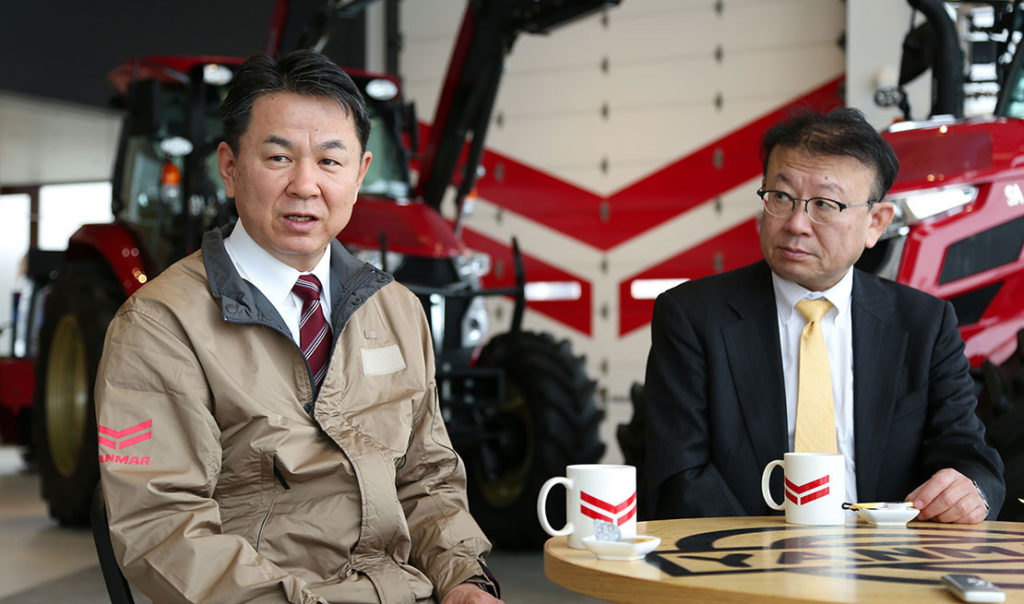
Noguchi Mr. Miura’s participation in the project fostered the concept of two coordinated units running at once. What’s more, this initiative drew attention from the public at large, earning Yanmar the Seventh Robotics Award (Minister of Agriculture, Forestry and Fisheries Award) in 2016, providing a substantial shot in the arm to Yanmar’s commercialization. It’s no exaggeration to say that Mr. Miura and Dr. Hidaka created the catalyst for turning robotic agricultural equipment into a commercially viable product.
Bringing Robot Tractors to the Market, and to the Future
Q. How did you feel when the autonomous tractor was developed in October 2018?
Noguchi Cooperation between university research institutes, agricultural equipment manufacturers, farmers that would use the equipment, and the MAFF who established safety maintenance guidelines contributed greatly to the success of bringing this product to market. A great number of people have been involved in our research up until now. Many graduate students are taking active roles in manufacturers in Japan and abroad after graduation, including Yanmar. Some, like Mr. Miura, are putting this into practice in the field of agriculture.
Miura Robot tractors were introduced in May 2019. I was involved from the prototype stage, so I’m quite satisfied to see the level of completion in the market product. It takes even the smallest farmer concerns into consideration, and an awful lot of work went into it. The farmers around me have also taken quite an interest in it.
Hidaka This project reinforced the importance of collaboration between farmers and developers when creating such equipment. Young engineers come into the company with hopes of working on robot tractors, precision agriculture, or related tasks. But first, we instruct them to go to actual farms and try out the work for themselves.
Q. How, in your opinion, must the Japanese agricultural industry evolve?
Noguchi I think the next themes of robotic agricultural equipment are “miniaturization” and “smart machinery.” Current robotic agricultural equipment is crafted with large-scale farms in mind, such as those in Hokkaido. But serious labor shortages are occurring in small-scale farms nestled in areas like mountainous regions. That’s why we need to miniaturize robotic agricultural equipment and reduce the cost. Full automation of monitoring work is another issue. At present, adequate fertilization and agrochemical dissemination are performed under human supervision, but this work can be done unmanned through smart machinery.
Miura Robot tractors will become the basis of future agriculture. This is because robot tractors can accumulate field information as data. Going forward, it will be possible to further reduce manpower by linking various work machines together. In addition to reducing manpower, precision agriculture using field information will become possible. By digitizing fertilization work, for example, we anticipate the ability to precisely control how much nutrients go in a field. We estimate this would reduce the cost of fertilization while raising the product quality.
Hidaka As a developer, I believe the next step is increasing the types of work that robot tractors are able to perform. Concurrently, development towards miniaturization for small-scale farms should get underway, as Dr. Noguchi stated. The agricultural industry must also become a smart industry. We at Yanmar aim for an agricultural industry with connected information, from production sites all the way to the consumer level. Use of fertilizer, agrochemicals and fuel will be adequately managed at production sites. And for consumers, we will deliver traceability information to create produce they can trust. Together, producers and consumers can realize an agriculture that works for society.
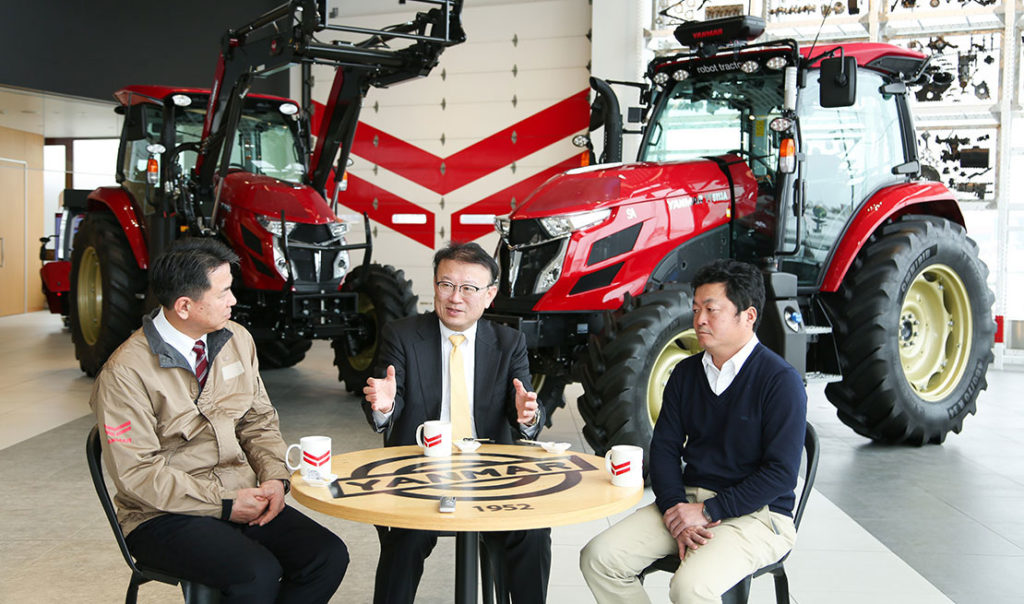
Q. In conclusion, I want to ask each of you what you wish to achieve in the future and what message do you have for the next generation?
Noguchi I would love to conduct research that supports a stable global food supply. I want to contribute our smart farming technology to realize a sustainable society where economic growth and a global environment can coexist. I want students to have big goals, and to pursue them without giving up. Our research is a large and ambitious one. I want you all to pursue your own dreams together with us.
Miura I want to streamline the agriculture industry more and more. Streamlining will lead to benefits. Benefits can be returned to our employees and help invigorate regions. In this era, you can make various connections over social media when considering things you would like to see happen. You can gather sympathetic ears in a short period and hold meetings online to exchange opinions. And when new themes arise, new connections are born with them. I hope those aspiring to next-generation agriculture join the industry over time, so we can tackle such issues together.
Hidaka I’m proud of having a job related to the agriculture industry, and I want to support small-scale farms doing their best in mountainous regions and the like. It may sound presumptuous, but I want to create an environment that will call youths back to the farm villages from the cities. For those aiming to become engineers, I want them to pursue their dreams without giving up and to really think through problems as they take on this challenge. I want people like that to rejuvenate the agriculture industry.
Noguchi Dr. Hidaka speaks of revitalizing the agriculture industry, and I also find it important to create an agriculture industry with a market-in approach considering what we want to create, and where we want to sell said creations going forward. I believe it is up to Japan’s agricultural equipment manufacturers to change agriculture industry systems in Japan and Asia. I expect great things from Yanmar’s pursuit of a food industry value chain from production to processing, to distribution, all the way to the consumer.
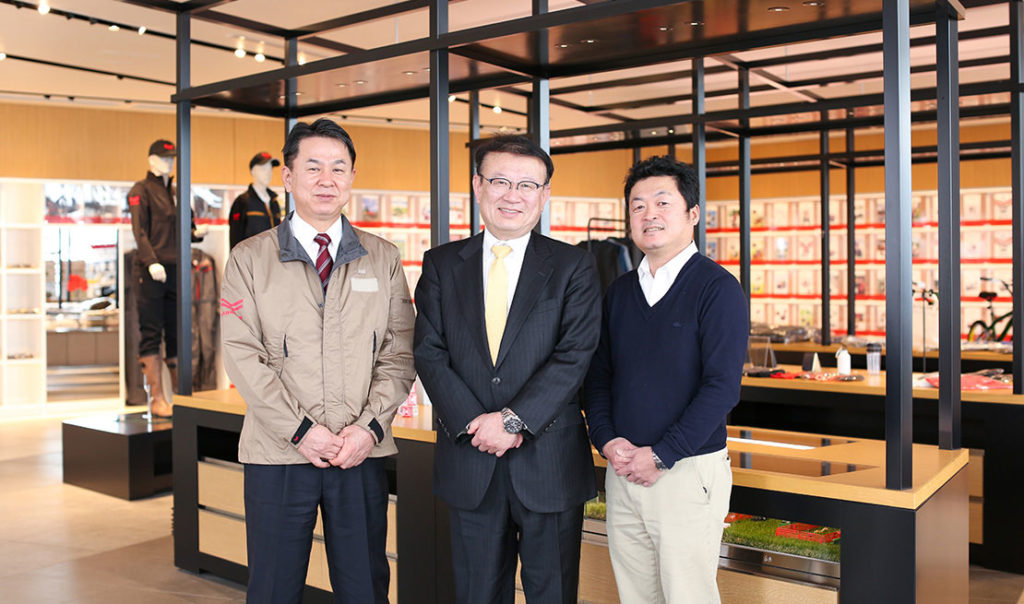

 Agriculture
Agriculture
 Recreational Marine
Recreational Marine
 Recreational Boat
Recreational Boat
 Premium Cruiser
Premium Cruiser
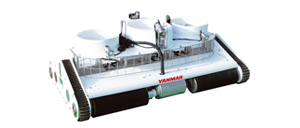 Marine Equipment
Marine Equipment
 Marine Commercial
Marine Commercial
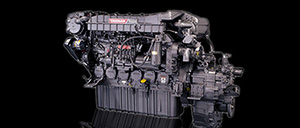 Propulsion Engines (High Speed)
Propulsion Engines (High Speed)
 Propulsion Engines (Medium Speed)
Propulsion Engines (Medium Speed)
 Auxiliary Engines
Auxiliary Engines
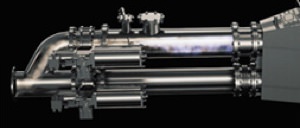 SCR System
SCR System
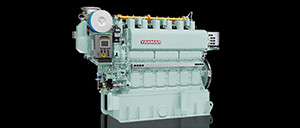 Dual Fuel Engine
Dual Fuel Engine
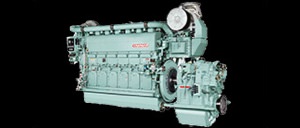 Two-stage Turbocharging System
Two-stage Turbocharging System
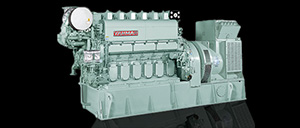 Electric Propulsion System
Electric Propulsion System
 Energy Systems
Energy Systems
 Construction
Construction
 Industrial Engine
Industrial Engine
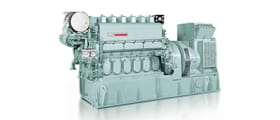 Large Generators
Large Generators
 Power Products
Power Products






















